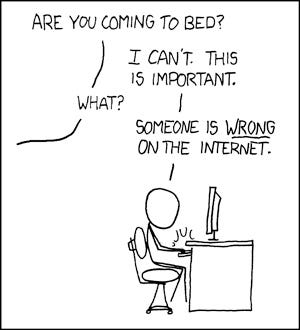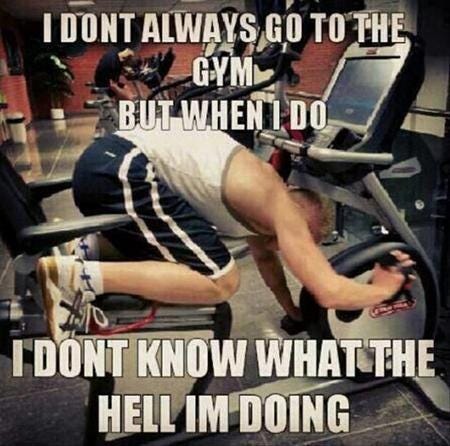Via xckd
While writing a 4 part series about my journey from a wide-eyed 24 year old SoulCycler to a 33 year old CrossFitter, I learned a lot. I also cut out a lot of angry tangents. Sometimes I write myself into these mansplaining eddies that make me look like Abe Simpson during his finest hour.
Yet the fact remains that the fitness industry is plagued by misinformation that complicates and ultimately impoverishes our understanding of exercise while enriching certain studios and personalities. I won’t stand for this and neither should you. Let’s get into 10 reasons why.
1. Hot yoga burns more calories than regular yoga.
The notion that hot yoga burns more calories than regular yoga makes a sort of “citizen scientist” intuitive sense (if it’s hot it should burn calories, right?), but calories don’t actually leave the body via sweat; they exit via exhalations. Heating yoga classes certainly makes them feel harder but hot yoga’s main documented effects are dehydration and an increased heart rate, not burning more calories.
2. Hot yoga is detoxifying.
There is even less evidence that hot yoga is detoxifying. You’re losing water, not toxins via the puddle on your yoga mat. If you’re interested in detoxifying, your body already has a wonderful system for doing this that involves your liver, your kidneys, and peeing and pooping. However, as long as you’re not shitting or pissing yourself in a hot yoga class, you’re not really detoxifying.
3. Classes that make you feel the burn like Pilates or Barre are the best way to achieve a “toned” physique.
A muscle can be larger or smaller, stronger or weaker, but “toned” is a hopelessly fuzzy term that boils down to “desirable.” While the idea of a toned physique helps sell Pilates, Barre, and yoga memberships, ironically these forms of exercise are relatively ineffective at achieving it. In reality, people that look “toned” have larger muscles with relatively less body fat, so changes to diet and lifting heavy weights will get you there more efficiently than endless Pilates pulses. As Insider puts it:
To get scientific about it, most forms of steady state cardio and workouts like pilates and barre work your slow-twitch muscle fibers. Lifting heavy weights and explosive movements like sprinting work your fast-twitch muscle fibers. It's the latter that have the greatest growth potential, so if you want to see visible muscle and create the "toned" look, that's what you should be focusing on.
4. If you lift heavy weights, you’ll end up bulky.
It’s honestly offensive to bodybuilders to think that anyone might get accidentally jacked. That’s like worrying that learning to snowboard will accidentally qualify you for the Olympics. Despite the truly immortal fears to the contrary pervading the fitness industry, female athletes in particular are extremely unlikely to end up “bulky” from weight training. For anyone to get visibly bulky muscles they must lift very heavy weights regularly, eat a lot of protein, and then lift even heavier weights. Most of us just aren’t going to work hard enough and be consistent enough with diet and recovery to actually get big. Instead, we’ll just get stronger and look a bit better in the mirror, which is ironically the very outcome almost everyone is after.
Lift away, just don’t skip leg day, Dumbbelldore.
5. Fitness influencers are trustworthy.
Many Instagram fitness influencers are slender, conventionally attractive 20 somethings who look great in a bathing suit. How could we not want to emulate their lifestyle if it comes with washboard abs and smoothies as verdant as the vistas in their Instagram feeds? My 3 gripes with fitness influencers are:
Their qualifications aren’t as visible as their muscles. Social media centers people who look hot over people who know what they’re talking about. Being young, looking great, and even being strong is no guarantee that this knowledge is transferrable in any way. A low body fat percentage reveals abdominal muscles, not wisdom. More important than do John and Jane have large shoulders or an enviable butt is the question: have they ever worked with people like you before and delivered results?
There’s a lot they aren’t showing you. While you tried their butt building routine and it certainly burned and felt hard, you just never know: what other exercises they’re doing besides all those donkey kicks and crunches, what their real diet is like, how much sleep they’re getting, their financial situation (looking pretty is often quite expensive), if they are on supplements or steroids, if they put on muscle more easily than you due to genetics, and what other invisible tailwinds they have at their back. You don’t even know what they actually look like. They may be benefitting from angles, lighting, editing, and other smoke and mirrors that your phone obscures.
The incentives of social media prioritize novelty over efficacy. Influencers are incentivized to produce content that’s engaging above all else, hence the focus on sex appeal, marketable gear, and appealing but quixotic goals like spot reduction of abdominal fat via crunches. However, the building blocks of an effective routine aren’t constantly changing your routine via new superfoods and gimmicky exercises; they are consistency, hard work, and a few tried and true types of habits and movements.
6. Recovery is optional. You should spend as much time lifting weights as possible.
Muscles aren’t built in the gym; they’re broken down there. You only build muscle when rest after the HIIT class is over. This is why proper recovery time, sleep, and nutrition matter so much. Your recovery days, diet, and sleep matter just as much as your hard lifts because they are what integrate and actualize the gains you’re making in the gym.
7. Weight machines are the most effective form of weight training.
Weight machines optimize the gym’s square footage, not your training goals. Like treadmills, they’re approachable and non-intimidating introductions to a type of exercise that you do many other ways, even with little or no equipment. They can also perpetuate the unfortunate stereotype that weightlifting is overly complicated or equipment intensive. While I’m aware that body builders love machines for their targeted focus on specific muscle groups, I have yet to come across compelling evidence why the general public should look primarily to weight machines for strength training. That’s just my five cents. If machines work well for you, awesome!
If you’re after strength gains, in my experience it’s compound movements like deadlifts, squats, cleans, and presses that provide a much bigger return on investment. For example, while a hamstring curl machine engages your muscles in a specific but limited range of motion, doing a deadlift requires you to use your hamstrings in concert with your glutes, lats, and core, through a full, lifelike range of motion. As an added benefit, all compound movements are also core exercises, as this is where your stability comes from, making crunches or planks much less necessary. Compound movements are what’s most applicable to our lives outside of the gym, are very challenging and effective when done with proper form, and are basically infinitely scalable to your current fitness level and training goals.
8. You need lots of different equipment and exercises to stay in shape.
One thing I realized in my 100th HIIT class was that for all of the different equipment I had learned how to use, they all converged around a few common movements. These are: squat, hinge, lunge, push, pull, rotation, and farmers carries, which do wonders for your grip strength and grocery bag carrying capacity. The seemingly infinite variety of exercises are all just creative riffs on these core concepts.
This is one of the biggest things people misunderstand about CrossFit. Despite its understandable but outdated reputation as an injury-prone cult, when properly coached Crossfit is a simple and approachable practice centered around moving better. As Kelly Starrett’s Becoming a Supple Leopard articulates, the point of exercise is to move through life with less pain and limitation and more control, strength, and stability. Learning and mastering the basic movement patterns is how this happens. It’s how you both identify and address your physical limitations. You can also achieve all of this this with relatively little. If you really wanted to be the Henry David Thoreau of gains, I firmly believe you could hole up in a cabin with two kettlebells and still get super strong with just a handful of exercises.
9. There is more debate than ever on which types of exercise are effective.
Fitness misconceptions are pervasive because it’s very profitable for exercise to seem more complex than it actually is. If it’s complicated then you must pay the right guru to enlighten you. While this is working well for the fitness, supplement, and diet industries, driving lots of clicks and selling lots of books, it hides the truth that what works is relatively simple and hasn’t actually changed much.
Ultimately, the methods are many but the principles are few. For example, regardless of their sport, almost all athletes train their posterior chain: the glutes and hamstrings. The old coaches adage that your power comes from your hips is oh so true. Whether you load the posterior chain with a barbell, dumbells, or a kettlebell is far less important than regularly loading it. For me, getting better at kettlebell swings, deadlifts, and cleans was what made me noticeably faster and more explosive on the frisbee field.
Even if you have no intent on ever playing sports, there’s a growing consensus that we should all be doing some form of resistance training since it delivers a buffet of benefits including: increasing bone mineral density, aiding heart health, slowing the muscle degeneration associated with the aging process, preventing cognitive decline, and causing you to burn more calories even when at rest.
Mastering the few basic movement patterns (see myth 8) and adding weight over time as form allows is widely agreed upon be basis to achieving nearly all fitness goals, whether adding muscle, losing fat, being better at a sport, or just moving through life with less pain.
10. There is one ideal way to be fit, healthy, or in shape.
There is no wrong way to exercise. What matters is incorporating movement into your life somehow. Swimming, running, yoga, Pilates, Zumba, rowing, Barre, spin, surfing, powerlifting, volleyball, CrossFit, horseback riding, pole dancing, and my beloved Spikeball are all equally valid ways to stay moving and stay healthy. The best one for you is the one you’ll enjoy doing regularly. While many runners could use to lift more weights just as many lifters could use a bit more cardio, the longest lived people on earth inhabiting the “Blue Zones” aren’t CrossFitters in Venice Beach, but Okinawans and Sardinians whose main forms of exercise are low-intensity activities like walking up a hill to see a friend, herding sheep, picking olives, or gardening.
The biggest takeaway from my years as a ClassPass pilgrim was that if you stay humble, curious, and open to new experiences, the wide world of exercise has a limitless amount of things to teach you. It’s also healthy and normal to transition between different types of them as your life, body, and goals change.
The most important thing to seek out and cultivate from exercise isn’t a burn or a specific physique. The real gains aren’t even physical; they’re learning to cultivate self-compassion and teaching yourself how to feel mentally and physically resilient in new and tough situations. Getting shredded pales in comparison to shredding your own misconceptions of what you’re capable of. The real progress doesn’t appear or even happen in your muscles or your lungs. Ultimately, the physical changes are almost just joyful side effects of learning to feel confident, grounded, and at home in your own body.
Know someone that needs to read about exercise misconceptions?
What do you think about the fitness industry?
Want to support my writing and never miss a post?




